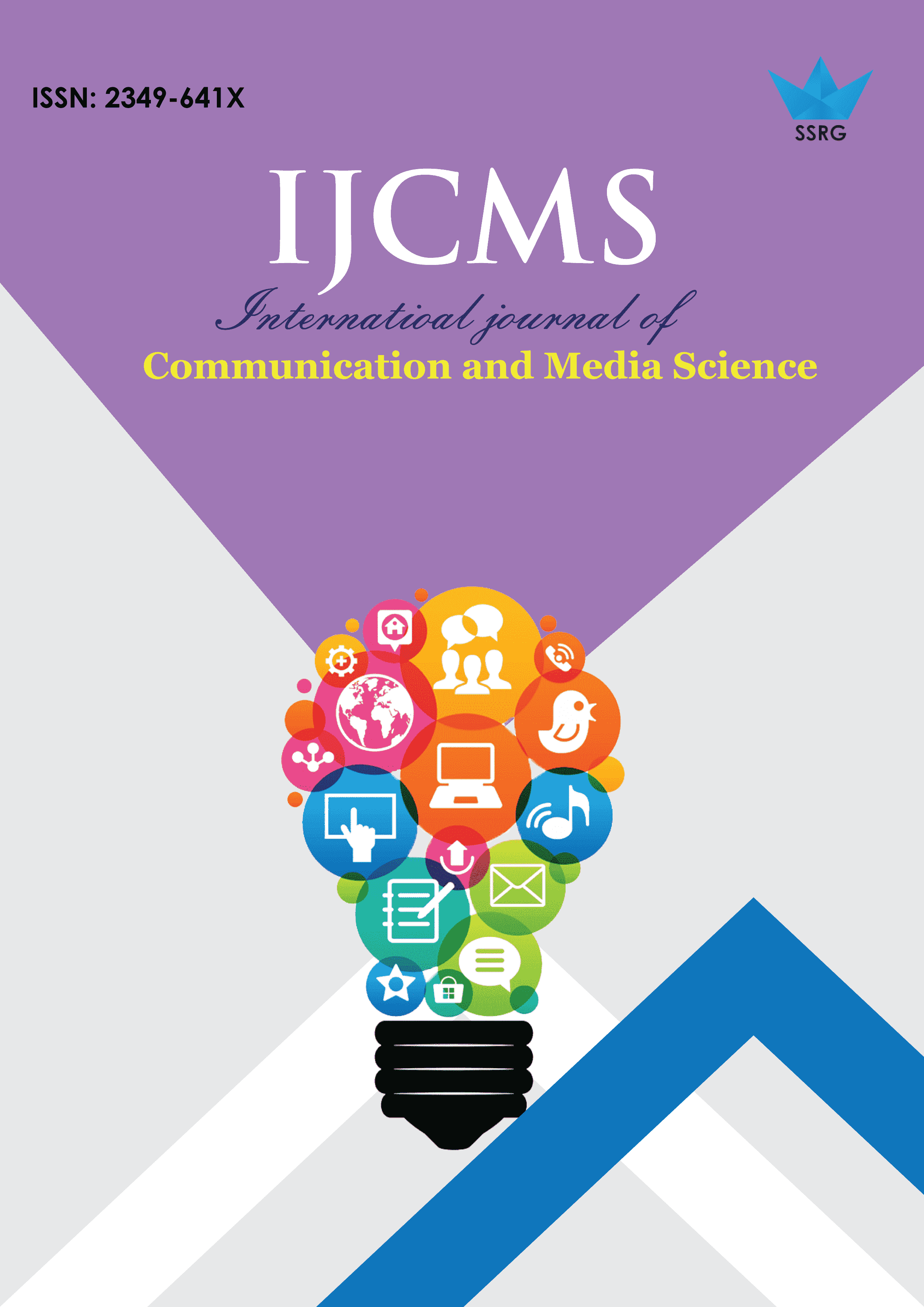Digital Communication Controlling Youngsters in Delhi, India, and Salalah, Oman: A Case Study

| International Journal of Communication and Media Science |
| © 2019 by SSRG - IJCMS Journal |
| Volume 6 Issue 3 |
| Year of Publication : 2019 |
| Authors : Dr. Sangeeta Tripathi, Ms. Muna Al Shahri |
How to Cite?
Dr. Sangeeta Tripathi, Ms. Muna Al Shahri, "Digital Communication Controlling Youngsters in Delhi, India, and Salalah, Oman: A Case Study," SSRG International Journal of Communication and Media Science, vol. 6, no. 3, pp. 7-14, 2019. Crossref, https://doi.org/10.14445/2349641X/IJCMS-V6I3P102
Abstract:
The new generation considers media technology as valuable assistance, while old and experience people take it as detrimental as well as beneficial. The internet has strengthened the ability to scan and learn faster, but it also influences learning and makes it complicated (Griffiths, 2000). This critical thinking led us to ponder over the relationship of technology with learning ability and forced us to examine its impact upon the youngsters’ attitude and expression towards the outer world. This research focuses on 3 to 13 years’ age group children as their developing minds can be easily ductile by frequent media exposure. News of kids committing suicide after playing online games, raise serious concern for everyone regarding the use of new media and its adverse effect. Our primary objective is to find out the reasons for the negative impact of media and new media without ignoring the positive side of the digital natives (Musgrove, 2008) (The Economist, 2010). The findings provide an insightful understanding of the technological influence on children's reasoning and learning ability, impact on their physical health, decision making ability, action and interaction to the outer world. The survey, observation, and case study method are applied to conclude the results.
Keywords:
Media and new media, digital devices, learning, digital natives, digital detox.
References:
[1] Al-Badi, A., Al Mahrouqi, S., and Ali, O. (2016), the Influence of the Internet on Teenagers’ Behaviour in Oman, Journal of Internet Social Networking &Virtual Communities, Vol. 2016 (2016), Article ID 171712, DOI: 10.5171/2016. 171712 Retrieved fromhttp://ibimapublishing.com/articles/JISNVC/2016/171712/171712.pdf
[2] AL-Saleem, N. (2012). Ways of Protecting Omani Children from the Internet: A Case Study of the Sultan School in Muscat, Oman. Journal of Arts and Social Sciences [JASS], Vol 3, No 1. Retrieved from: https://journals.squ.edu.om/index.php/jass/article/view/1041/1016
[3] Clark-Pearson, O’Keeffe (2011), The Impact of Social Media on Children, Adolescents, and Families. American Academy of Paediatrics. VOLUME 127 / ISSUE 4. Available at: https://research3.fit.edu/sealevelriselibrary/documents/doc_mgr/1006/O'Keeffe_and_Pearson._2011._The_Impact_of_Social_Media_on_Children,_Adolescents,_and_Families.pdf
[4] Griffiths, M. (1998). Internet addiction: Does it exist? In J. Gackenbach (Ed.), Psychology and the internet: Intrapersonal, interpersonal and transpersonal applications (pp. 61–75). New York: Academic Press. Retrieved from: https://www.academia.edu/780572/Griffiths_M.D._1998_._Internet_addiction_Does_it_really_exist_In_J._Gackenbach_Ed._Psychology_and_the_Internet_Intrapersonal_Interpersonal_and_Transpersonal_Applications._pp._61-75._New_York_Academic_Press?auto=download
[5] Griffiths, M. (2000), Internet addiction -- Time to be taken seriously? [editorial] Addiction Research 2000; 8 (5):413-418. Retrieved from: http://www.tandfonline.com/doi/abs/10.3109/16066350009005587?journalCode=iart19 [6] Internet users in India to reach 627 million in 2019: Report, ET TELCOM, Retrieved from https://economictimes.indiatimes.com/tech/internet/internet-users-in-india-to-reach-627-million-in-2019-report/articleshow/68288868.cms
[7] Khanna, P., (2014), 93% students in India access internet every day. Retrieved from: https://www.livemint.com/Politics/PSq0aCdEQTkbFa3LwghGSM/93-students-in-India-access-Internet-everyday.html
[8] Musgrove, M. (2008), Talkin' About the Digital Generation. Washington Post. Retrieved afrom:
http://voices.washingtonpost.com/posttech/2008/10/tech_podcast_features_john_pal.html?nav=rss_blog
[9] Rideout, V. J., Foehr, U. G., & Roberts, D. F. (2010), Generation M2: Media in the Lives of 8- to 18-Year-Olds. Retrieved from: https://www.kff.org/wp-content/uploads/2013/04/8010.pdf
[10] Rosen, L.D., (2011), Social Networking’s Good and Bad Impacts on Kids. Retrieved from: http://www.apa.org/news/press/releases/2011/08/social-kids.aspx
[11] The Economist (2010), Technology and society: Is it really helpful to talk about a new generation of "digital natives" who have grown up with the internet? The Economist. 4 March 2010. Retrieved from: http://www.economist.com/node/15582279
[12] UNICEF (2016), Child Online Protection in India. Retrieved from:https://www.icmec.org/wp-content/uploads/2016/09/UNICEF-Child-Protection-Online-India-pub_doc115-1.pdf

 10.14445/2349641X/IJCMS-V6I3P102
10.14445/2349641X/IJCMS-V6I3P102